Plzeň and searching for Beroun
The next day we left the camping after breakfast. Just after we left it started to rain. Initially we went into the direction of Prague. In the first stretch we didn't make much progress
because of the winding roads. After an hour we had only travelled about 45 kilometres. Sometime later we ended up in a traffic jam, due to an accident and one of the lanes was closed.
From Prague onwards to Plzeň it is a four-lane highway on which we could make up some of the time lost earlier. When we arrived in Plzeň we walked to the central square and
admired the town hall from which a newly wed couple left and the next one was standing by to enter the town hall. When such a wedding cortege drives through the streets there is a lot of
hooting and other loud noises. And as we saw several of these corteges when we were in Plzeň we were constantly surrounded by a lot of noise. Most couples marry on a Saturday because
wedding ceremonies last two days and so nobody has to take a day off from work. So on a Saturday it is a coming and going of brides and bridegrooms at the town hall. Because the city of
Plzeň also lent its name to 'pilsener' beer, a large part of the town is dedicated to the beer Pilsener Urquell (Primeval spring of Pilsener). We also made a tour through a part
of the tunnels under the city. In early days these tunnels were used to store storage and for maturing the beer in large casks. There are also many wells with very clear water in the
underground tunnels. During the tour you see about 20 of these wells, but in total there are about 700 of them under the city. The whole tour lasts for about half an hour and
it is very interesting. Also, at last, the explanation of the guide was also in English and not only in Czech. Although we had the idea that our guide told a lot more in Czech than she
did in English. From the Plzeň underground we went to the beer museum, not far from the entrance to the underground world of the city. The museum shows the history of beer making.
A small part is dedicated to the origin of beer, long before Christ, in ancient Egypt. The larger part of the exhibition deals with the history of beer making in this city. This
museum is definitely worth a visit when in Plzeň. After visiting the museum we had a drink on a terrace, it had stopped raining, before we went off for Beroun. Beroun is a very
small hamlet east of Mariánské Láznĕ, our route planner wasn't aware of the place. At last, via small, winding local roads we arrived at around 5 pm in Beroun
where the road ended at farmyard. Also the only crossroad in the hamlet ended at a farmyard. There was no boarding house to be found, especially not in a street that had a house with
number 879. So we continued to the next village, also nothing. At last we drove to the next larger town, Tepla. From there we called the boarding house, it turns out that the Beroun
we need to go to is one of those Berouns with a post-fix appended, just south of Prague. We agreed that we would arrive around 8 pm. From Tepla we drove to another larger town, Plana,
where we had dinner. After also feeding the car we drove to Beroun at high speed. From Plana first on local roads and after a few kilometres on the highway all the way back to Plzeň.
Near Plzeň there is some road construction going on and you have to continue on local roads but after that there is again a nice stretch of 4-lane highway all the way to Prague.
We had to take the exit at Beroun. There we had to search, but luckily there were some signs directing us to the Nostalgie boarding house and at 8 sharp we arrived. A friendly woman with
a little baby on her arms welcomed us and showed us our large room with 3 beds. After we put all our stuff in the room we idled for the remaining part of the evening.
The town hall and some façades in Plzeň
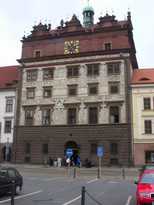
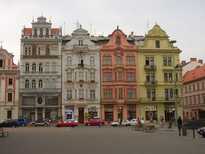
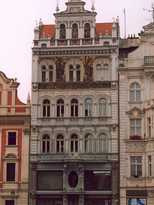
Prague
A daytrip to Prague. With our car we drove to a metro station where we parked the car on a guarded parking place. From there we took the metro to the centre of Prague. The ride lasted
about 30 minutes. On a Prague guide, Hilleke had found a walking tour that guided you along most of the tourist sites in the city, the Royal Tour. The first site we came along was the
Powder Gate. During our walk from the metro station to the Powder Gate we had come along some artistic cows. The so-called 'Cow Parade' is now done in Prague, 4 years ago we had also seen
one in Calgary. Because of all these cows, this day was already a success for Ciska, and we would see a lot more of them during the day.
She had to pet every cow we came along and she also tried to feed them. From the Powder Gate we walked to the Old Town Square (Staromestské Námestí) where we sat down
to have something to drink. Eating in drinking in Prague is much more expensive than in other parts of the Czech Republic, they charge you Western Europe prices. For two coffee and a glass
of apple juice we had to pay 300 crowns, about 10 euro. We walked around the square and admired all sights, including of course the famous astronomical clock in the tower of the city hall.
But, frankly speaking, the only in Olomouc appealed us more than this one in Prague, at that one we could at least determine what time it was. But here in Prague we were not able to read
the time from the clock. After doing dome more sights we returned to the clock at noon to see the procession of the 12 apostles. A large crowd had gathered in front of the clock to see it.
When at 12 o'clock the show was started by the skeleton, depicting Death, by pulling a rope. At that moment a large part of the audience cheered and clapped their hands. While the
skeleton admires the hour-glass in his other hand, two windows opens and 11 apostles and St. Paul show up. After about one minute the show is over and then everyone leaves. Next we walked
via the Little Square (Male Námestí) towards the famous Charles Bridge, also an obvious tourist trap. There are very many tourists and the whole bridge is crammed with
stands at which they sell a lot of rubbish. At the other end of the bridge we stopped at a restaurant to have lunch with a view on the bridge. The weather, by the way, was very warm and
sunny. So we were glad we had a table with a large parasol so we could sit in the shade. After lunch we continued the tour to the Prague Castle. Guided by our guidebook we visited a part
of this vast castle. We started in the large St Vitus's Cathedral. A very nice cathedral on the inside, beautiful stained glass windows and also lots of very fine woodcarvings among which
a large wooden map of Prague in former days. After having visited the crypt we walked to the Golden Lane. In early days the gunners and guards of the Castle lived in this pretty lane.
After another drink we left the castle to find a restaurant to have dinner. Not far from the Castle we found one and after dinner we took the metro and car back to our boarding house.
It had been a tiring and warm day. We have seen very many pretty things, actually one day is too short to visit Prague, there are so many things to see here. Also Ciska had a great day,
mainly due to all the cows scattered all over the city.
Below a number of pictures of Prague
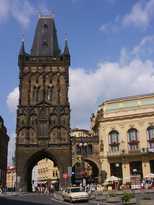
The Powder Gate
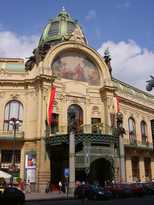
The stately entrance of the Obeční Dům (community house)
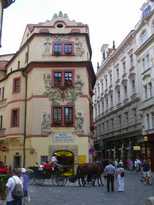
Splendid building near the Old Town Square
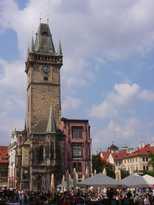
Prague city hall
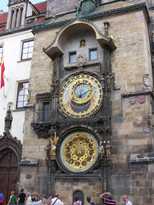
The famous astronomical clock near the city hall
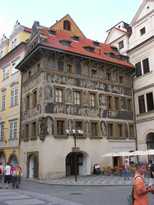
House next to the city hall
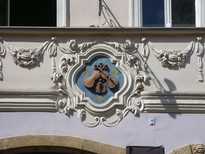
House with the 3 violins
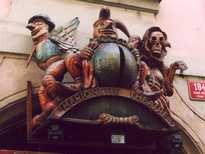
Woodcarving above the entrance of a marionette theatre
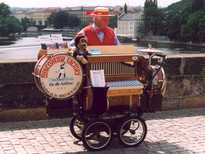
Street-musician on Charles Bridge

The famous Charles Bridge

View on Prague Castle from Charles Bridge
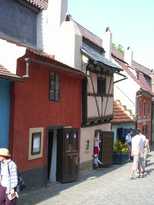
The Golden Lane in Prague Castle
And some cows of the Cow Parade
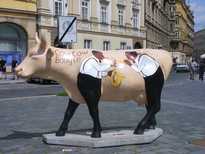
Cow Cow Boogie
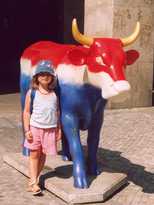
Ciska in front of a Dutch cow
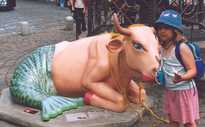
Mercow
Karlstein castle and Mariánské Láznĕ
The next day after breakfast we drove towards Karlstein castle, not far from Beroun. Via winding roads through the mountains we arrived at the parking place near the castle. It is not
allowed to drive all the up to the castle and according a sign at the parking place it was a long and steep road to the castle. But there is also a taxi or horse and carriage that could
take you up the hill. The first one attracted Hilleke, Ciska was more in favour of the second one. When we asked the attendant about the timetable of the taxi it turned out that the
castle is closed on Mondays. Yes, we could have known that, on Mondays most museums and such are closed. But according some people returning it was worth it going through the village
and watch the castle from there. Also the road into the village was not that far and steep. After a short walk we already saw the castle rising high above the village. it really looks
like a castle from a fairy-tale. Most souvenir shops are open on Mondays, but not all. Also here a lot of shops selling Bohemian crystal and glassware. Some items are really beautiful,
but some are also very large or fragile that we doubt whether we will manage to get it home in one piece. We only buy some small things or things that are very well packed. After admiring
the castle from down below we had something to drink before returning to our car to go to Mariánské Láznĕ. Mariánské Láznĕ is
famous for its spas. In and around town there are a lot of mineral springs that are supposed to be healing. After visiting the Tourist Office and lunch we continued our way into town.
It is, by the way, a hopeless city to drive, a lot of one-way streets or streets that you may only enter with a special permit. So you definitely need a map to get from point A to
point B. After parking the car we walked towards the Maxim Gorki Colonnade, one of the main attractions of the city. In the pouring rain, the whole day we had looked at a grey overcast sky. Also
during our trip to this town we had some rain, but from the moment we left the car it really started to pour. At the Colonnade we walked through it and drank mineral water from
a number of springs. Most of them didn't taste very well. What stroke us was the fact that the average age of the people walking around was lowered by our presence, it are mainly elderly
people visiting this place. They probably have the highest needs for the healing water, although all posters only depict beautiful and smiling young women in a bath. Because of the
rain we didn't want to visit more of the town and decided to find an internet cafe to search for a place to stay. It turned out that we had parked our car in front of another Tourist
Office that also had public internet PCs. While Arjan checked the mail, Hilleke organised a place to stay. We are staying in a hotel on a hill just outside town, hotel Panorama.
Via a small and winding road up the hill we arrived at the hotel. Our first impression was one of: "In what kind of decaying mess have we ended up now?". But when we entered the lobby all
looked much better. A lady guided us to our room, but as soon as we left the lobby the sadness of fallen grandeur stroke us. Stairs telling of better times and beautiful leaded glass
windows. We walked over shabby carpets through high, sad looking corridors. The lady told us that we are the only guests in the hotel. The hotel is being renovated, our room was ok,
equipped with a new installed toilet and bathroom. This hotel is one of the oldest in Mariánské Láznĕ, it opened up in 1872. In its glory days it undoubtedly must
have been a very luxurious hotel for that time. But during the communist era the hotel probably was neglected and now it is being restored to its old grandeur with modern luxury. So maybe
in a few years it is again one of the high ranked hotels in this town and you probably have to pay a lot more for a room than we did. After dragging all our luggage up (there is no elevator)
we took a rest in our room before returning to town to have dinner.
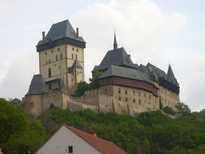
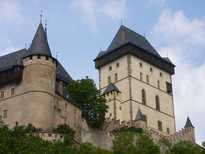
Fairy-tale castle of Karlstein
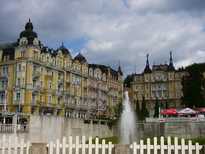
19th century gentleman's houses in Mariánské Láznĕ

The Colonnade in Mariánské Láznĕ
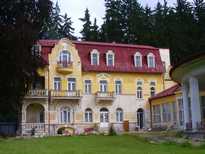
Hotel Panorama
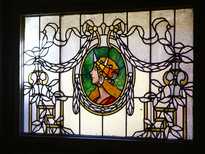
Leaded glass window in the hotel
Karlovy Vary
Daytrip to Karlovy Vary, another even more famous place with spas and other health resorts not far from Mariánské Láznĕ. Karlovy Vary is also a place in which most
of the houses in the old centre are from the mid 19th century. Also Karlovy Vary is a maze with one-way streets, which make getting to your destination in this town not an easy task. But
when we succeeded in finding a parking place we first went to a terrace to have something to drink and next we discovered the town in search for the Tourist Office. Most of the springs in
town can be found at or near several Colonnades. This is the place where the curing people can pick up their 'private' jug and fill it with the sometimes very warm water, sometimes with
temperatures between 50 and 70 °C. We also tried some of the water, and, same as in Mariánské Láznĕ, we didn't like it. We also went for a look at the spring
that was discovered first, the Vřídlo spring or Hot Spring Fountain. This one has a temperature of around 74°C and the water sometimes goes to a height of 12 metres and it
produces large clouds of steam. Many famous people have cured in this place like tsar Peter the Great, emperor Josef II and Johann Sebastian Bach. After walking around it was about time
for lunch and while we were eating it started to rain. But that was already gone before we had finished our lunch. The rest of the day, the sky often looked threatening but there was no
more rain. It wasn't a very warm they as well by the way. After lunch we walked to the cable railway with which you can go to the top of a hill from which you have a splendid view over
Karlovy Vary and its surroundings. On top of that hill there is also a watchtower from which you have an even better view. After having an ice-cream we descended again but we left the
cable-railway at the middle station and walked from there to see the small statue of a chamois that looks out over the city. The legend tells that emperor Charles IV discovered the springs
during a hunting party. A deer jumped over a large rock and his dogs also tried to jump over it, but they ended up in a warm spring. A physician investigated the water and he discovered
that the water had healing effects. The statue of the chamois (not a deer) is a commemoration for this event. From the small statue of the chamois we descended further into town. There
we wandered around some more before returning to our car to drive back to our private hotel. When we arrived there we admired the large ballroom that was opened now, it really looks
impressive. Enormous chandeliers are hanging from a beautifully decorated ceiling and there are large mirrors on the walls, this room definitely has an atmosphere of a long gone era.
When the restoration of the hotel will be ready in a few years from now all will undoubtedly look very impressive again.
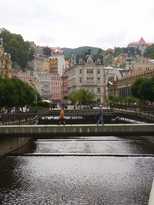
View on Karlovy Vary with the Tepla river

The Park Colonnade in Karlovy Vary.
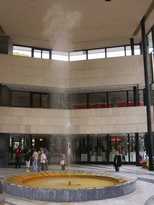
Spouting Vřídlo spring (=Hot Spring)

Tapping water at one of the many springs (Mill Spring)